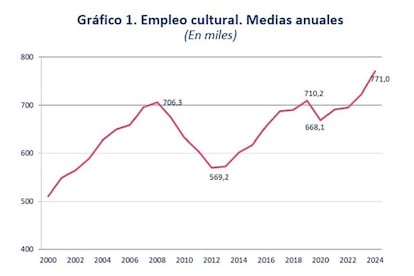Cultural employment grew in 2024 by 6.6% compared to the previous year, reaching a total of 771,000 people. This consolidated increase in the recovery of the cultural sector after the Covid-19 pandemic crisis, by exceeding 8.6% the figure recorded in 2019, prior to the pandemic, according to data from the Ministry of Culture extracted from the National Statistical Plan prepared by the INE. However, with respect to total employment in Spain, the percentage is equal to that registered in 2019: 3.6%, according to the INE.
Before the pandemic, in 2019, cultural employment was 710,000 workers. However, in 2020 the sector suffered a sharp fall of 6%, losing 42,100 jobs compared to the previous year. The health crisis especially impacted the activities related to the performing arts, live shows and the audiovisual sector, due to restrictions and cessation of activities. In the subsequent years, the sector initiated a progressive recovery, with increases in employment of 4.2% in 2022 and 5.1% in 2023, already being able to level the figure before the COVID, until reaching the current current figure of 771,000 occupied in 2024.
Regarding the quality of employment in the cultural sector, since 2022 there is a significant increase in indefinite contracts against storms. In this period, indefinite contracts increased by 19%, while the storms decreased by 9.1%. This means, in absolute terms, 33,300 indefinite contracts rather than in the previous year. In addition, the full -time employment rate remains high, standing at 88.6%, compared to 11.4% part -time, a stable trend in the last three years.
In the section that analyzes statistics in terms of gender, the increase in female employment stands out in 2024, when a total of 22,400 women joined jobs in the sector. Regarding age groups, it highlights the increase in cultural employment among young people aged 16 to 34 in 19,900 jobs more than the previous year. Likewise, the data reveals that cultural employment is characterized by an academic training higher than the average, presenting a higher education rate of 71.2%, compared to that observed in the national group, which is 46.7%.
These figures from the National Statistics Institute are referred to the employment that is developed in companies dedicated to cultural activities, such as editing activities, libraries, archives, museums, cinematographic, video, radio and television, or artistic and shows , among others. Along with this, the employment that corresponds in occupations with a cultural dimension, writers, artists, archivists or librarians is contemplated.

